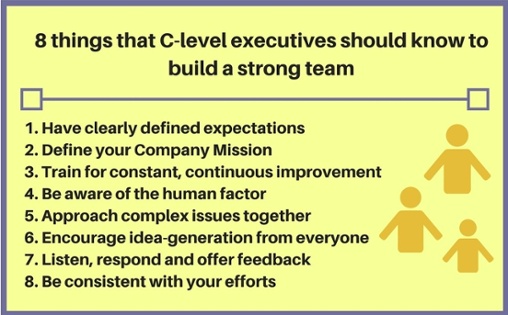High performing teams are the goal of any successful organization. Who doesn‘t want to constantly meet deadlines, deliver excellent quality work and have close to zero problems during the completion process of every project? Unless you are masochistic in the extreme (like THE extreme), you probably understand what you can achieve with the help of such people.
There is an ancient proverb that goes “If you want to go fast, go along, if you want to go far, go together.”
A well-formed team brings out the best in every person – complementing each other‘s strengths and mitigating weaknesses while providing ideas and putting in the collective amount of work needed to achieve incredible results.
Here are 8 things every C-level executive must keep in mind when trying to build “the dream team”:
1. Have clearly defined expectations
Whenever you onboard a new team member, they need to know exactly what your vision and goals are. Even if the person excels at what he does, it shouldn‘t be the only focus of his work. Each team member has weaknesses and strengths. Make it clear that you expect them to leverage their strengths not on the individual level, but at the team level.
Research has shown that 70% of on the job learning occurs informally, which means that experienced team members can contribute a lot more than simply excelling at their job.
For example, if you onboard a new saleswoman who has years of experience under her belt, her job should not only be bringing in as many customers as she can but to help the rest of the sales department get better at what they are supposed to do. This might sound like a paradox since if the person doesn‘t fully focus on her job as a sales rep, you will get fewer customers per month than you might have had otherwise.
However, from a greater perspective, reprioritize your thinking and set your expectations in a way that the goal is to help others as a team rather than a collection of individual employees. You will come out ahead on the team level, which is much more important to any company. In our example, the time spent by the high-performing, experienced saleswoman on mentoring the rest of your sales staff will pay off not only for the individual sales reps but also for your team as a whole.
2. Define your Company Mission
The company‘s mission and vision shouldn‘t only be for the senior management. To really achieve the desired results, every team member should be aware of company values and overall vision.
The truth is that people are more motivated and productive at doing their jobs when they have a clear sense of purpose.
Understanding the mission and vision is one thing, but being a part of it is quite another. As a C-suite executive, it‘s your job to make team members feel part of something greater and give them all the tools necessary to succeed. Make your mission statement specific, and easy to understand. Having something general like “help clients to grow their business” won‘t be as effective as, for example, Facebook‘s mission statement:
Founded in 2004, Facebook‘s mission is to give people the power to share and make the world more open and connected. People use Facebook to stay connected with friends and family, to discover what‘s going on in the world, and to share and express what matters to them.
An effective mission statement will not only let your team know why your company exists but will reaffirm that they really are part of something great.
3. Train for constant, continuous improvement
In the fast-paced business world of today, it‘s essential to stay up to speed with the latest trends, innovations, and breakthroughs in your industry. Even if you bring in the best people with the latest knowledge about everything today, their effectiveness and productivity will naturally decline over time without continuing development.
Continuous improvement is not only one of the most important factors of strong team building, but it has also actually become a real need for many employees around the world. Research and surveys have shown that learning and development opportunities are the most motivating factors for employees nowadays (voted by 34% of the respondents).
This gives all the more reason to invest in and organize training sessions for your team members. Continuous training and improvement will not only make your staff more motivated to work, but also increase their productivity and effectiveness while on the job.
4. Be aware of the human factor
“Failure is not the opposite of success; It‘s a part of success.” – Arianna Huffington
Let‘s be real here – even the strongest teams in the world make mistakes.
It‘s important to understand that the human factor will always be there, no matter what. Mistakes will happen, but a single mistake doesn‘t necessarily signal the end of the world. On the contrary, every misstep is an excellent opportunity to learn as a team. Focus on identifying, analyzing, and learning from mistakes, instead of hopelessly expecting them to never happen.
There are countless accounts of how businesses have failed, but the ones that succeed have made mistakes but learned from the experience.
As a C-level executive, it‘s critical to install this kind of problem-solving approach in your team members. Whenever something goes wrong, the team should work together to get to the core of it, learn why it happened, and how to prevent it from happening again. The whole process should be about developing a mindset that treats mistakes as opportunities to improve, rather than simply a failure to deliver on expectations.

5. Approach complex issues together
Some tasks and challenges often have deeper roots than you might first assume. Trying to tackle those individuals will often result in more problems than solutions, because, on the team level, people won‘t understand what‘s going on. This will lead to communication breaches and considerably increased error margins.
This is why it is important to have an organized, cumulative approach to complex problems. The key to this approach is accountability. When the whole team is gathered together to solve an issue, it‘s not about a C-suite executive demanding improvements anymore: it‘s about the whole team working together to correct mistakes and pursue improvements.
6. Encourage idea generation from everyone
The formulation of great ideas is sometimes misunderstood as being the responsibility of only the top management or the C-suite. However, these people already have a lot on their hands and most of the time, they simply don‘t have enough time to look into matters carefully, let alone organize the execution of new ideas.
Oftentimes, great solutions and ideas don‘t come from the top management or the C-suite. It‘s the actual team members that generate incredible ideas and help the company deal with complex issues, address challenges, and come out ahead of the competition.
Generating great ideas is one thing while helping your team to think in the right direction for the company and turn their ideas to life is quite. While it‘s important for every person to know that his or her voice will be heard, seriously considered, and taken into account, it‘s also important to guide your team‘s idea generation in the right direction.
On top of that, it‘s rare that another person will understand the thought process and formulation of the idea better than the originator. For these and many other purposes, it is important to encourage and empower your team members to not only generate ideas but also proceed with their implementation.
This kind of an approach will not only greatly increase the motivation of your team members, but also make them understand that they are indeed a part of something bigger and can participate actively in all activities aimed to grow the company. Everybody‘s ideas, however wild they may be, matter a lot more than it may seem at first glance.
Take note of these 10 examples of intrapreneurship, most notably Gore-Tex. By dedicating 10% of their employees‘ time to brainstorming, the manufacturer of wearable waterproof fabrics was able to become the best selling acoustic guitar string manufacturer because of a junior team member‘s idea.
It doesn‘t matter much about the role assigned to each member of your team; great ideas can come from anywhere. Maybe your designer has a brilliant idea for marketing, or your HR manager has a great idea for redesigning your company logo.
7. Listen, respond, and offer feedback
Good listening and monitoring skills are essential to building a strong and flexible team. As a C-level executive, your job is to identify potential risks and problems within your team before they occur and threaten to do any damage.
Every person is unique in their own way and it‘s important to show, more or less, a personalized approach to each person and their problems, challenges, and desires. The thing is that people are social creatures and they need to feel supported by seniors in their workplace. It gives a sense of belonging and improves their motivation to work with somebody who at least hears them out.
It‘s very important to realize the difference between listening and hearing. Hearing people out is the first step, but doing something to improve the situation is quite another. Your team members will be open to sharing their concerns and challenges with you, but unless you act accordingly or offer some kind of actionable feedback, their trust in you will slowly diminish, taking down productivity and motivation with it.
Listen, respond, and act based on the information you gather from your team members, and never leave a concern unattended. Even if you can‘t deal with it on the spot, it‘s still important to acknowledge the problem and try to do something about it. Whether what you do works out in the end or not isn‘t really that important, since you at least gave it a try.
8. Be consistent with your efforts
One last thing to keep in mind is that you need to be consistent with your efforts. Whether you decide to implement the ideas mentioned in this article or go with any other approach, consistency will always be the key to successfully building a strong, highly performing team.
Positive changes are always welcomed by employees, but at the same time, you can‘t expect people to jump in wholeheartedly right away. There will always be doubts that this might be just a one-time thing, or the positive changes won‘t last for long. Don‘t get discouraged by such behavior and keep on pushing in the same direction. The more good stuff that happens and stays implemented, the more people will gladly seek to participate in improving team-related processes.



